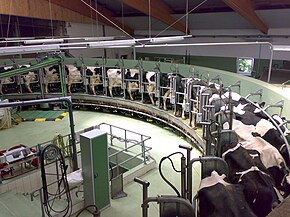The universal minimum income support is like feeding a cow to get the milk. The universal minimum income support is the cow feed. The sales tax revenue is the milk. The rats(12th generation indentured servants) spit in the milk when they wanted to know their position just as the noose of automation got closer and closer. It happened in the 1920's when Hoover designed his vacuum cleaner.
Rotolactor
The Rotolactor is the first invention for milking a large number of cows successively and largely automatically, using a rotating platform. It was developed by the Borden Company in 1930, and is known today in the dairy industry as the "rotary milking parlor".[1][2]
History
The Rotolactor was the first invention for milking a large number of cows using a rotating platform.[3][4] It was invented by Henry W. Jeffers.[3][5] The Rotolactor was initially installed in a "lactorium," a building specifically designed for milking cows, in Plainsboro, New Jersey.[3] The rotating mechanical milking machine was first used by the Walker-Gordon Laboratories dairy and was put into operation on November 13, 1930.[3][6]
Jeffers conceived the idea for the Rotolactor in 1913 as a cost-cutting and labor-saving method for milking a large number of cows. Development of the project was put on hold during World War I. In 1928, the Walker-Gordon Laboratories dairy was purchased by the Borden Company, and Rotolactor development resumed in earnest.[7] Borden provided $200,000 in 1929 for building the Rotolactor at the Walker-Gordon Laboratories dairy farm.[8]
Description
The first line of the Abstract of the 1930 Cow Milking Apparatus (Rotolactor) patent starts:
The Rotolactor (roto + lactor ium) was a large rotating "merry-go-round" style platform[10] for holding 50 cows.[8] The machine brought the cows into position for milking with automatic milking machines. The rotating platform machine was sixty feet in diameter and made one complete revolution about every twelve and a half minutes, which was the time required to prepare and milk each cow.
The first step for each new cow was receiving a bath. They were bathed with warm water and automatic showers, supplemented by two men using pressure hoses, who "devote their attention to the cleansing of udders and flanks."[11]
The next operator prepared the udder for the milking. Then the teat-cups of the automatic milking machine were attached to the cow's udder. The cow was then milked for the twelve and a half minutes during the Rotolactor's one-time complete rotation. The teat-cups would then be detached at the end of the twelve and a half minute rotation.[12] The cow would then step off the platform and return to the barn to her stall.[6]
The milk was drawn by a vacuum to sealed glass containers above the cow's head.[10] It was then transported in pipes to weighing and recording apparatuses.[6] Then it was piped to another room where the milk was cooled and bottled.[10] This was faster and more efficient than the methods previously used.[6] Human hands never touched the milk, and the milk never came into contact with air,[6] which was important to prevent premature spoiling.[6] The Rotolactor could milk the Walker-Gordon dairy's 1,680 cows three times daily.[6] This produced 26,000 quarts of milk.[8]


Comments
Post a Comment